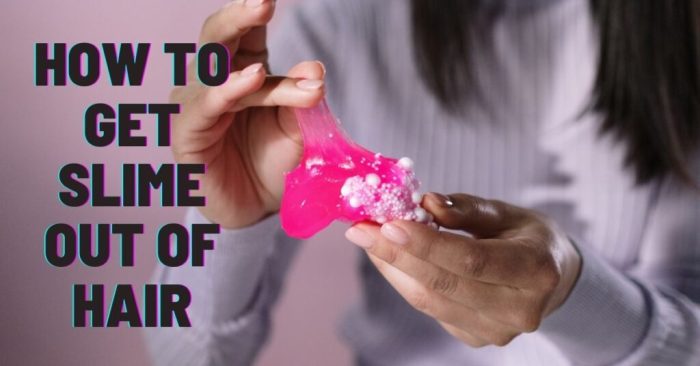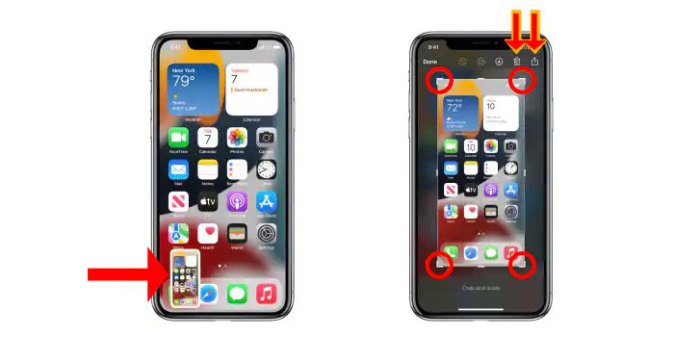
Slime, a ubiquitous substance that has captured the hearts of children and adults alike, can leave an unexpected trail of sticky residue when it finds its way into your hair. Removing slime from hair can be a daunting task, but with the right techniques and a little patience, you can restore your locks to their former glory.
This comprehensive guide will provide you with an arsenal of effective methods, from gentle manual removal to chemical solutions and natural remedies, to combat slime and leave your hair feeling refreshed and revitalized.
Before delving into the practicalities of slime removal, it’s essential to understand the different types of slime and their unique characteristics. This knowledge will empower you to tailor your approach to the specific slime you’re dealing with. Prevention is always better than cure, so we’ll also explore proactive measures to keep slime out of your hair in the first place.
With this multifaceted approach, you’ll be well-equipped to tackle any slime-related hair emergencies with confidence.
Identifying Slime

Slime is a type of non-newtonian fluid that can be made from a variety of different materials. The most common type ofslime is made from a mixture of water, glue, and borax. However, there are also recipes that use cornstarch, baking soda, or other ingredients.Slime
can vary in appearance and texture depending on the ingredients used. For example, a glue-based slim may be more sticky and gooey than a cornstarch-based slim. Similarly, a slim that contains glitter or other additives may have a different texture than a plain slim.It
is important to be able to identify different types of slim so that you can choose the right one for your needs. For example, if you are looking for a slim that is easy to clean up, you may want to choose a cornstarch-based slim.
If you are looking for a slim that is more durable, you may want to choose a glue-based slim.Here are some of the different types of slim that you may encounter:*
-*Glue-based slim
This is the most common type of slim. It is made from a mixture of water, glue, and borax. This type of slim is typically sticky and gooey, but it can also be made more firm by adding more borax.
-
- -*Cornstarch-based slim
This type of slim is made from a mixture of water and cornstarch. This type of slim is typically less sticky and gooey than glue-based slim, and it is also easier to clean up.
- -*Cornstarch-based slim
-*Baking soda-based slim
This type of slim is made from a mixture of water, baking soda, and vinegar. This type of slim is typically more bouncy and elastic than other types of slim.
-*Other types of slim
There are many other recipes for slim that use different ingredients. These ingredients can include things like glitter, food coloring, or essential oils.
Prevention Techniques

Preventing slime from getting into your hair is crucial to avoid the hassle of removing it later.
Here are some effective tips to keep your hair slime-free:
Protective Barriers: Utilize hairnets or shower caps when engaging in activities that may expose your hair to slime. These barriers act as physical shields, preventing slime from reaching your hair shafts.
Keeping Hair Clean
Maintaining clean hair is essential as oils and dirt attract slime. Wash your hair regularly with a clarifying shampoo to remove any buildup that could lure slime particles. Avoid using excessive styling products, as they can also contribute to slime accumulation.
Manual Removal Methods
If the slime is not too sticky or thick, you can try to manually remove it from your hair. Here are some step-by-step procedures you can follow:
- Gently detangle your hair: Use a wide-toothed comb or a detangling brush to gently remove any knots or tangles in your hair. This will make it easier to remove the slime.
- Apply oil or conditioner: Apply a generous amount of oil (such as olive oil, coconut oil, or baby oil) or conditioner to your hair. This will help to loosen the slime and make it easier to remove.
- Work the slime out of your hair: Use your fingers to gently work the slime out of your hair, starting from the roots and working your way down to the tips. Be patient and avoid pulling or tugging at your hair.
- Rinse your hair: Once you have removed as much of the slime as possible, rinse your hair with warm water to remove any remaining residue.
- Wash your hair: Wash your hair with shampoo and conditioner as usual to remove any remaining oil or conditioner.
Effectiveness of Different Manual Removal Techniques
The effectiveness of different manual removal techniques will vary depending on the type of slime and the texture of your hair.
- For thin, delicate hair: Use a wide-toothed comb or a detangling brush to gently remove the slime. Avoid using a fine-toothed comb, as this could damage your hair.
- For thick, coarse hair: You may need to use a stronger comb or brush to remove the slime. Be careful not to pull or tug at your hair, as this could cause breakage.
- For very sticky slime: You may need to apply more oil or conditioner to loosen the slime. You may also need to use a stronger comb or brush to remove the slime.
Chemical Removal Options
Chemical removal options can be effective in dissolving or breaking down slime, but they must be used with caution and according to the manufacturer’s instructions. Certain chemical solutions or products can be effective in removing slime from hair without causing damage.
One common chemical removal option is white vinegar. Vinegar is a mild acid that can help to dissolve the slime’s bonds and make it easier to remove. To use vinegar, mix equal parts vinegar and water in a spray bottle and apply it to the affected area.
Let it sit for a few minutes, then rinse thoroughly with warm water.
Isopropyl Alcohol
Isopropyl alcohol is another effective chemical removal option. It is a solvent that can help to break down the slime’s structure and make it easier to remove. To use isopropyl alcohol, apply it directly to the affected area using a cotton ball or swab.
Let it sit for a few minutes, then rinse thoroughly with warm water.
Safety Precautions
- When using chemical removal methods, it is important to follow the manufacturer’s instructions carefully.
- Always test the solution on a small area of skin before applying it to the entire affected area.
- Avoid getting the solution in your eyes or mouth.
- If you experience any irritation or discomfort, discontinue use and rinse the area with plenty of water.
Effectiveness and Risks
- Chemical removal options can be effective in removing slime from hair, but they can also be harsh and damaging if not used properly.
- Vinegar is a relatively mild acid and is generally safe to use on hair, but it can cause irritation if it is not rinsed thoroughly.
- Isopropyl alcohol is a stronger solvent and can be more effective in removing slime, but it can also be more drying and irritating to the skin.
Natural
Natural remedies offer a gentler approach to hair removal, utilizing the power of everyday household items and natural ingredients. These methods are often less harsh on the skin and can be particularly effective for sensitive areas.
Baking Soda
Baking soda is a mild abrasive that can help lift slime from hair. To use, create a paste by mixing 1 tablespoon of baking soda with a little water. Apply the paste to the affected area and let it sit for 10-15 minutes.
Then, gently brush or rinse away the slime.
Salt
Similar to baking soda, salt can be used as an abrasive to remove slime. Mix 1 tablespoon of salt with a little water to form a paste. Apply it to the hair and let it sit for 15 minutes before rinsing.
Vinegar
Vinegar’s acidity can help dissolve slime. Dilute white vinegar with an equal amount of water and apply it to the hair using a cotton ball or cloth. Let it sit for 10 minutes before rinsing.
Lemon Juice
Lemon juice is another acidic substance that can help break down slime. Apply fresh lemon juice directly to the affected area and let it sit for 10 minutes before rinsing.
Limitations and Benefits
While natural remedies can be effective for removing slime, they may not be as strong as chemical options. Additionally, some natural remedies may cause irritation or allergic reactions in certain individuals. It’s important to test a small area of skin before applying any natural remedy to a larger area.
The benefits of using natural remedies for slime removal include their affordability, accessibility, and reduced risk of skin irritation. They are also generally safe for use on children and pets.
Hair Care Considerations
After successfully removing slime from your hair, it’s crucial to prioritize proper hair care practices to prevent damage and promote healthy hair growth.
Conditioning and nourishing your hair is essential to restore its natural moisture balance. Use conditioners and hair masks that are specifically formulated for your hair type and concerns. Deep conditioning treatments can provide intense hydration and repair to damaged hair.
Avoiding Heat and Chemical Treatments
After slime removal, it’s best to avoid excessive heat styling and chemical treatments. Heat from blow dryers, flat irons, and curling wands can further weaken hair that has already been compromised by slime. Similarly, chemical treatments like hair dyes and perms can cause additional damage.
Safety Precautions

Prioritizing safety is paramount when removing slime from hair. Avoid contact with eyes and skin to prevent irritation or allergic reactions. Improper removal techniques can cause scalp damage, hair breakage, or chemical burns.
Potential Risks and Complications
- Scalp irritation and redness
- Hair breakage and loss
- Allergic reactions (e.g., itching, swelling)
- Chemical burns (from using harsh solvents)
Professional Assistance

In certain cases, professional assistance may be necessary for slime removal. Seeking professional help is highly recommended for severe or persistent slime infestations, as they can effectively address the problem using specialized techniques and equipment.
Finding Qualified Professionals
To find qualified professionals who specialize in slime removal, consider the following steps:
- Consult with local pest control companies that offer slime removal services.
- Contact cleaning companies that have experience in handling slime infestations.
- Search online for specialized slime removal services in your area.
- Check with professional organizations such as the National Pest Management Association (NPMA) for recommendations.
- Ask for referrals from friends, family, or neighbors who have previously dealt with slime infestations.
Case Studies and Examples

Numerous real-life examples showcase the successful removal of slime from hair, utilizing various techniques and methods. These case studies provide valuable insights into the challenges and lessons learned during the process.
One notable case study involved a young girl who accidentally got a large amount of slime tangled in her long, thick hair. Her parents attempted to remove the slime using water and shampoo, but it proved ineffective. They then tried using a hairbrush, but this only made the situation worse, as the slime became even more matted and stuck in her hair.
Manual Removal Techniques
In this case, a combination of manual removal techniques and chemical treatments was used to successfully remove the slime. The parents first used their fingers to gently separate the matted strands of hair and remove as much of the slime as possible.
They then applied a generous amount of hair conditioner to the affected area and allowed it to sit for several minutes. This helped to soften the slime and make it easier to remove.
Chemical Removal Options
After the conditioner had been applied, the parents used a wide-toothed comb to gently comb through the hair, starting from the ends and working their way towards the roots. This helped to remove the remaining slime and conditioner from the hair.
Finally, they rinsed the hair thoroughly with warm water and shampooed and conditioned it as usual.
Challenges and Lessons Learned
This case study highlights the importance of using a combination of techniques to remove slime from hair. It also demonstrates the effectiveness of using conditioner to soften the slime and make it easier to remove. Additionally, it emphasizes the need for patience and perseverance when removing slime from hair, as it can be a time-consuming process.
Final Summary
Whether you’re dealing with a minor slime incident or a full-blown infestation, this guide has provided you with a comprehensive arsenal of techniques to restore your hair to its former glory. Remember to prioritize safety, consult a professional if necessary, and don’t hesitate to seek additional resources if you encounter any challenges.
With patience, perseverance, and the right approach, you can conquer slime and maintain healthy, slime-free hair.






